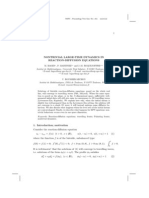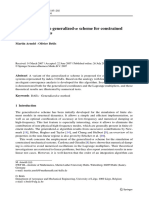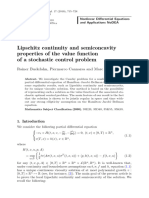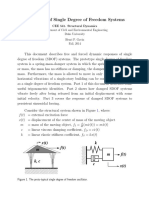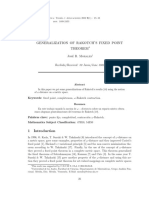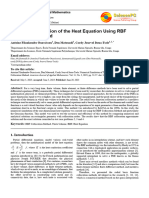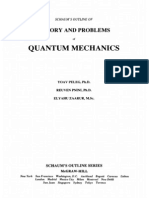Car Act A Bat A
Car Act A Bat A
Uploaded by
mariusz19781103Copyright:
Available Formats
Car Act A Bat A
Car Act A Bat A
Uploaded by
mariusz19781103Original Title
Copyright
Available Formats
Share this document
Did you find this document useful?
Is this content inappropriate?
Copyright:
Available Formats
Car Act A Bat A
Car Act A Bat A
Uploaded by
mariusz19781103Copyright:
Available Formats
Finite element characteristic methods
requiring no quadrature
Olivier Pironneau
LJLL, Universite Pierre et Marie Curie, Place Jussieu, Paris F-75005
E-mail: pironneau@ann.jussieu.fr
in honor of M. Tabata for his sixtieth birthday
Abstract
The characteristic methods are known to be very ecient for
convection-diusion problems including the Navier-Stokes equations.
Convergence is established when the integrals are evaluated exactly,
otherwise there are even cases where divergence has been shown to
happen. The family of methods studied here applies Lagrangian con-
vection to the gradients and the function as in Yabe[?]; the method
does not require an explicit knowledge of the equation of the gra-
dients and can be applied whenever the gradients of the convection
velocity are known numerically. We show that converge can be sec-
ond order in space or more. Applications are given for the rotating
bell problem.
Keywords Finite Element Method, Characteristic-Galerkin, convection-
diusion equation.
1 Introduction
Let u be solution of the convection-diusion-dissipation equation in a bounded
open set over a time interval (0, T)
t
u +a u (u) +bu = f, u(0) = u
0
in , t < T (1)
with a smooth positive diusion , smooth convection velocity a, dissipa-
tion coecient b and source f. For simplicity we assume a, b independ of t,
constant, and with homogenous Neumann boundary conditions,
n
u = 0
on (0, T).
1
To obtain a second order method in time when f = 0 one may use Strangs
operator splitting as in Beale-Majda[1] and compute
u
m+1
= D
t/2
oC
t
oD
t/2
u
m
where D
u
0
is the solutions at time of
t
u (u) +bu = 0, u(0) = u
0
, (2)
and C
u
0
is the solution of
t
u +a u = 0, u(0) = u
0
(3)
As this last equation says also that the total derivative of u((t), t) along
the characteristic curve (t) is zero, a discretization is u
m+1
(x) = u
m
(X(x))
where X(x) is (t
m
) when (t
m+1
) = x.
Alternatively one may use
1
t
(u
m+1
u
m+1
) (u
m+1
) +bu
m+1
= 0, u(0) = u
0
,
with u
m+1
(x) = u
m
(X(x)) where X(x) = x ta(x
t
2
a(x)) (4)
The scheme is O(t
2
) + O(Ct) but C tends to zero with + b. In a
large class of applications and b are small and so in practice it might be
enough. Still, the diculty then is to nd a second order nite element
approximation of this scheme, stable even if = 0.
Many research papers deal with this problem (see [5] and the references
therein and more recently [3] [2] [6]) . The usual approach is to write the
scheme in weak form and discretise by the nite element method. However
all proofs require exact quadrature for the term containing u
m+1
which
in turn implies that the nite element mesh and the convected mesh are
intersected. Since this is too costly, we propose here an alternative based
on an idea due to Yabe[?] which has been shown very accurate numerically
but which has not yet been proven to work theoretically.
Consider (3) in (0, T) with a, u
0
smooth a = 0 and a n = 0 on the
boundary. The semi-analytical solution of this problem can be written in
terms of the Lagrangian coordinate (t), solution of
(t) = a((t)), (t
0
) = x
0
(5)
where t
0
and x
0
are arbitrary time and point. The solution is
u((t), t) = u(x
0
, t
0
),
a formula which is based on the observation that d
t
u((t), t) = 0. Thus
with a nite dierence of the time derivatives and by choosing t
0
= t
m+1
and x
0
= x we build the following second order scheme:
u
m+1
(x) = u
m
(X(x)) with X(x) = x a(x a(x)
t
2
)t (6)
We recall the denition of an m
th
order scheme:
2
Denition If u(, ) denotes the exact solution of the partial dierential
equation and if u
m
() denotes the numerical solution at time t
m
by some
numerical scheme, if there exists C such that
|u
m
u(, t
m
)|
Ct
p
then the scheme is said to O(t
p
), or p-order accurate.
Lemma 1.1 Scheme (6) is second order accurate
Proof
To check the consistency one replaces u
m
in (6) by u(x, t
m
), the exact
solution at time t
m
and performs a Taylor expansion of the right hand
side. This shows that the scheme is second order consistent; since stability
is obvious from (6), by the von Neumann lemma the scheme is second order
accurate.
1.1 Standard nite element discretization
The simplest discretization in space is to appy the scheme at the center of
gravity q
k
c
of each triangle T
k
:
u
m+1
h
(x) = u
m
h
(X(q
k
c
)) x T
k
k (7)
Proposition 1.2 Scheme (7) is O(
h
t
+ t
2
) and best at t = h
1/3
in the
sense that for some constant C independent of h and t
|u
m
h
u(, t
m
)|
|u
m
h
u
m
|
+ |u
m
u(, t
m
)| C(
h
t
+t
2
) (8)
Proof
Applying a Taylor expansion to u
m+1
gives
[u
m+1
h
(x) u
m+1
(x)[ = [u
m
h
(X(q
k
c
)) u
m
(X(q
k
c
)) + u
m+1
()(x q
k
c
)[
|u
m
h
u
m
|
+ |u|
h |u
0
h
u
0
|
+ |u|
hT
t
(9)
Hence (8) holds
The same argument works for a P
1
approximation and convection at
the vertices
Proposition 1.3 Let
i
3
1
be the barycentric coordinates of x T
k
(see
(22)). The scheme
u
m+1
h
(x) =
i=1,2,3
i
u
m
h
(X(q
i
)) x T
k
k (10)
3
is O(
h
2
t
+t
2
) and best at t = h
2/3
The proof is also given in Lemma 4.1. The fundamental remark for this
paper is that the argument does not work for P
2
element, however by
applying it to the gradients we gain on order of convergence in space.
2 Convection of the gradients
To obtain a second order scheme in space for (3) we intend to convect the
function u and its gradients v(x, t) =
x
u(x, t). For clarity we consider
only the case b = f = 0. Notice that v satises a vector equation like (30)
with = 0 and b = a:
t
v +av + (a)v = 0, v(0) = u
0
(11)
So in principle a characteristic nite element scheme based on an analytic
formula for (11) could be used; however our numerical tests indicate that
it is better to dierentiate (6) rather than to use (11). This leads to:
v
m+1
(x) = X(x)v
m
(X(x)) (12)
Lemma 2.1 The solution of (11) satises
v(x, t
m+1
) := u(x, t
m+1
) = X(x)v(X(x), t
m
) +O(t
3
) (13)
so Scheme (12) is second order accurate because
|v
m+1
v(, t
m+1
)|
(1 +ct)|v
m
v(, t
m
)|
+Ct
3
(14)
Proof
v(X(x), t
m
) = [v ta(x a
t
2
)v +
t
2
2
v
aa][
x,t
m +O(t
3
)
and
X(x) = I a(x)t +
t
2
2
((a
)a + (a)
2
)(x) +O(t
3
) (15)
Therefore placing the exact solution into the scheme gives
v(x, t
m+1
) = (I at +
t
2
2
((a
)a + (a)
2
))
v tav +
t
2
2
aav +
t
2
2
v
aa
[
x,t
m +O(t
3
)
= v(x, t
m
) t(av +av)[
x,t
m
4
+
t
2
2
(a
av + (a)
2
v + 2aav
+aav +v
aa)[
x,t
m +O(t
3
)
= [v +t
t
v +
t
2
2
tt
v][
x,t
m +O(t
3
)
which is correct because by (3) for v:
tt
v = a(av) +v
aa +aa
v + a(av) + (a)
2
v
Finally (14) is found by subtracting (13) from (12).
3 Discretisation with P1 discontinuous ele-
ments
To solve numerically (3) in (0, T) we use u
m
, X dened in (6). As
mentionned earlier this time scheme is O(t
2
) .
Scheme (6) is discretized in space by a discontinuous piecewise linear
approximation on a triangulation T :
u
m+1
h
(x) = X(q
c
)u
m
h
(X(q
c
))(x q
c
) +u
m
h
(X(q
c
)) (16)
for all x T the triangles of the triangulation; q
c
denotes the center of
gravity of T. Notice that this is equivalent to saying that u
m+1
is recon-
structed from its gradient and its value at q
c
and that these are obtained
by the method of characteristics from the values at the previous time step.
Proposition 3.1 When h Ct, the method is L
-stable in the sense
that |u
m
h
|
C
h
t
+ |u
0
h
|
.
Proof
By construction u
m+1
h
(x) = X(q
c
)u
m
h
(X(q
c
)) for all x T with center
q
c
; hence by (15)
|u
m+1
h
|
(1 +ct)|u
m
h
|
(1 +ct)
T
t
|u
0
h
|
.
Similarly [u
m+1
h
(x)[ |u
m
h
|
[x q
c
[ + |u
m
h
|
so
[u
m+1
h
[
h(1 +ct)
T
t
|u
0
h
|
+ |u
m
h
|
which proves the proposition.
5
Theorem 3.2 The method is O(h) in the sense that
|u
m
h
u(, t
m
)|
C(
h
2
t
2
+t
2
)
hence optimal at t = O(h
1
2
).
Proof
Let v
m
= u
m
and v
m
h
= u
m
h
; then for some between x and q
c
[v
m+1
h
v
m+1
[(x) = [v
m+1
h
(q
c
) v
m+1
(q
c
) u
m+1
()(x q
c
)[
= [X(q
c
)(v
m
h
v
m
)(X(q
c
)) +O(|u
h)
(1 +ct)|v
m
h
v
m
|
+C|u
h (17)
Hence
|u
m
h
u
m
|
< C(h +
h
t
) (18)
Similarly, using the following Taylor expansion (which relies on the fact
that x and q
c
are in the same triangle)
u
m+1
(x) = u
m+1
(q
c
) + u
m+1
(q
c
)(x q
c
)
+
1
2
u
m+1
)(x q
c
)(x q
c
) (19)
leads to
[ u
m+1
h
u
m+1
[(x) = [u
m+1
h
(q
c
) u
m+1
(q
c
)
+(u
m+1
h
(q
c
) u
m+1
(q
c
))(x q
c
) +
1
2
[u
m+1
(
)(x q
c
)(x q
c
)[
|u
m
h
u
m
|
+ |u
m+1
h
u
m+1
|
h + |u
h
2
2
C
h
2
t
2
(20)
4 Discretisation with P2 discontinuous ele-
ments
Convection of the gradients The scheme (12) for v is discretized in
space by continuous nite elements of degree one on triangles:
v
m+1
h
(x) =
i=1,2,3
i
X(q
i
)v
m
h
(X(q
i
)) (21)
where q
i
are the vertices of the triangulation and
i
i=1,2,3
the barycen-
tric coordinates of x, i.e.
x =
i=1,2,3
i
q
i
i=1,2,3
i
= 1 (22)
6
Lemma 4.1 Let v
m
h
m
be given by scheme (21) and let u
m
m
be dened
by the time scheme (6), for (11). Then
|v
m+1
h
u
m+1
|
(1 +ct)(|v
m
h
u
m
|
+Ch
2
Proof
Dene the space error = v
m
h
v
m
, then
m+1
(x) = v
m+1
h
(x) v
m+1
(x) =
i=1,2,3
i
w
m
h
(q
i
) w
m
(x)
where w
m
(x) = X(x)v
m
(X(x)), w
m
h
(q
i
) = X(q
i
)v
m
h
(X(q
i
)).
Again using the fact that x, q
i
are in the same triangle, a Taylor expan-
sion gives
w
m
(q
i
) = w
m
(x) + (q
i
x) w
m
(x) +
1
2
(q
i
x)
T
w
m
(
i
)(q
i
x)
for some
i
. Hence
i=1,2,3
i
w
m
(q
i
) = w
m
(x) +
i=1,2,3
i
2
(q
i
x)
T
w
m
(
i
)(q
i
x)
Therefore, we have
|
m+1
|
max
k
[
i=1,2,3
i
(w
m
h
(q
i
) w
m
(q
i
))[
T
k
+sup
x,k
[
i=1,2,3
i
2
(q
i
x)
T
w
m
(
i
(x))(q
i
x)[
T
k
max
k
max
i,q
i
T
k
[X(q
i
)(v
m
(X(q
i
)) v
m
h
(X(q
i
)))[
T
k
+sup
x,k
[
i=1,2,3
i
2
(q
i
x)
T
w
m
(
i
(x))(q
i
x)[
T
k
(1 +ct)|
m
|
+C|v
h
2
2
(23)
where c and C are functions of |a|
and of |a
.
Remark 1 Note that we use explicitly the fact that the hat function
i
is
positive, and this is why this proof does not work for nite elements with
non-positive hat functions such as the P
2
element.
7
Convection of the function The approximate gradients v
m
h
, can be
computed on (0, T) independently of u but we need to be able to construct
at any time t
m
= mt an approximate value, u
m
h
of u(, t
m
), with the best
accuracy.
On each triangle the function u
h
which approximates the solution of (3)
is reconstructed from its approximate gradient v
m
h
and a value at one point,
say
k
, for instance the center of gravity, of each triangle T
k
. Hence at each
time step u
m
h
is a second order polynomial on each triangle, discontinuous
at the edges.
More precisely, v
m
h
is computed by (21) and being linear in x there
exists A R
22
such that, for all x T
k
v
m
h
(x) = A(x
k
) +v
m
h
(
k
) (24)
Then we compute u
m
h
by
u
m
h
=
1
4
(x
k
)
T
(A
m
k
+(A
m
k
)
T
)(x
k
) +v
m
h
(
k
)(x
k
)
+u
m1
h
(X(
k
)) (25)
Note that u
m
h
is never used and that v
m
h
,= u
m
h
.
Lemma 4.2 Equation (26) written at the 3 vertices has one and only one
solution A.
Proof
Let us choose a coordinate system where q
1
= (h
1
, h
2
)
T
, q
2
= (0, h
3
)
T
,
(q
3
= (0, 0)
T
; let b
i
j
= v
m
h
(q
i
)
j
v
m
h
(q
3
)
j
. Then the linear system for A is
a
11
h
1
+a
12
h
2
= b
1
1
a
21
h
1
+a
22
h
2
= b
1
2
a
12
h
3
= b
2
1
a
22
h
3
= b
2
2
(26)
The solution exists and is unique for all non degenerate triangles.
Lemma 4.3
|u
m
h
u
m
|
C
h
2
t
Proof
|u
m
h
u
m
| |u
m
h
v
m
h
| + |v
m
h
u
m
| (27)
Lemma 4.1 gives a bound for the last term on the right, so let us focus on
the rst term on the right. By construction
v
m
h
(x) = A
m
k
(x
k
) +v
m
h
(
k
)
8
=
1
2
(A
m
k
+ (A
m
k
)
T
)(x
k
) +v
m
h
(
k
) +
1
2
(A
m
k
(A
m
k
)
T
)(x
k
)
= u
m
h
(x) +
1
2
(A
m
k
(A
m
k
)
T
)(x
k
) (28)
Let u
m
h
be the P
2
interpolate of u
m
. Then [u
m
u
m
h
[ ch
2
and
u
m
h
(x) = B(x
k
) + u
m
h
(
k
)
for some 2 by 2 symmetric matrix B. Therefore
1
2
(A
m
k
(A
m
k
)
T
)(x
k
) =
1
2
((A
m
k
B) (A
m
k
B)
T
)(x
k
)
This is an expression which involves only the values of w(x) := v
m
h
(x)
u
m
h
(x) at the vertices.
By inspection of (26), there exists a constant C such that [A
m
k
B[
C|w|
/h, which, by (28) and with C denoting
C
2
max
|x
k
|
h
implies that
|v
m
h
u
m
h
|
C|v
m
h
u
m
h
|
Finally, replace u
m
h
by u
m
at the cost of a ch
2
to obtain in (27)
|u
m
h
u
m
|
(1 +C)|v
m
h
u
m
|
+Cch
2
which, by Lemma 4.1, is less than C
h
2
t
.
Theorem 4.4 The absolute error between the exact solution of (3) and
the one computed by convecting the gradients at the vertices and function
at the center of each triangle, i.e. (21,25), is of order 3/2 in the sense that
whenever u and a are twice continuously dierentiable in space and time.
|u
m
h
u(, t
m
)|
C(
h
3
t
2
+t
2
)
which is optimal at t = h
3/4
.
Proof
Let u
m
be the solution of the scheme in time (6). A Taylor expansion shows
that, for some T
k
,
(u
m+1
h
u
m+1
)(x) = (u
m+1
h
u
m+1
)(
k
)
+ (u
m+1
h
u
m+1
)() (x
k
)
= (u
m
h
u
m
)(X(
k
)) + (u
m+1
h
u
m+1
)() (x
k
)(29)
9
The rst term on the right is bounded by |u
m
h
u
m
|
; the last term
is bounded by h|u
m+1
h
u
m+1
|
, which, according to Lemma 4.3 is
O(h
2
/t), therefore
|u
m+1
h
u
m+1
|
(1 +ct)|u
m
h
u
m
|
+C
h
3
t
and the nal result stems from the bound |u
m
u(, t
m
)|
Ct
2
.
Remark 2 When f ,= 0 it suces to add on the right hand side (f(q
i
) +
f(X(q
i
))/2. When b ,= 0 v and u are coupled so it needs some eort to
adapt the proof but it can be done. Notice also that there are elds for im-
provement, for instance by choosing
k
to be the points which convects into
the local max or min of u on each T
k
the method becomes non-oscillatory.
Notice also that it would have made more sense to replace v
m
h
by u
m
h
once
u
m
h
is computed, but the proof of convergence with such change is open.
By convecting u and u and each component of u
at the centers of gravity
and then reconstructing a P
2
polynomial in each triangle, we may be able
to achieve a better error.
5 Discretisation with Q2 elements
When the domain is quadrangulated, the gradients are approximated by
a standard continuous Q
1
vector valued function on the quadrilateral ele-
ment, the function on each quadrilateral is
u
h
[
R
k
= ax
2
y +bxy
2
+cx
2
+dy
2
+fx +gy +e
where x, y is in a reference frame whose origin is at the center
k
of the
rectangle R
k
so that e = u
h
(
k
) and all other parameters are determined by
the 2 gradients at the 4 vertices (there is a compatibility condition so one
data is redundant, namely a=b). Thus, with q
i
= (x
i
, y
i
)
T
, any solution of
(30) will do:
2x
1
y
1
y
2
1
2x
1
0 1 0
x
2
1
2x
1
y
1
0 2y
1
0 1
2x
2
y
2
y
2
2
2x
2
0 1 0
x
2
2
2x
2
y
2
0 2y
2
0 1
2x
3
y
3
y
2
3
2x
3
0 1 0
x
2
3
2x
3
y
3
0 2y
3
0 1
2x
4
y
4
y
2
4
2x
4
0 1 0
x
2
4
2x
4
y
4
0 2y
4
0 1
a
b
c
d
f
g
u
h
(q
1
)
u
h
(q
2
)
u
h
(q
3
)
u
h
(q
4
)
(30)
We conjecture that a similar proof as for the triangular elements may be
contructed to show that the method is O(t
2
+
h
3
t
2
). If such is the case
then the method is optimal at t = h
3/4
.
10
6 The convection-diusion equation
When f = b = 0 the fully discretized scheme is
1
t
(u
m+1
h
u
m+1
h
, w
h
) +(u
m+1
, w
h
) = 0 (31)
for all w
h
V
2
h
, the space of P
2
piecewise quadratic functions. Here to
avoid quadrature on the term (u
m
h
oX, w
h
) (the usual characteristic nite
element method) we replaced u
m
h
oX by u
m+1
h
computed by one time step
of the algorithm of the previous section with u
m
h
as initial condition.
Proposition 6.1 Let t
> h and assume that we could prove that:
| u
m+1
h
u
m
oX
m
| |(u
m
h
u
m
)| +C(h|u
m
h
u
m
| +t
3
+h
3
) (32)
where the norms are L
2
and u
m
M
1
is the solution of
u
m+1
u
m
oX tu
m+1
= 0,
u
m+1
n
[
= 0 (33)
(this corresponds to (23) with L
2
norms instead of L
). Then the scheme
(31) would be O(
h
3
t
+t
2
).
Proof
The scheme (33) is O(t
2
+
t). Let
h
be the projection operator on V
2
h
with the scalar product (, )+t(, ). Then with w
h
= u
m+1
h
h
u
m+1
in (31):
|u
m+1
h
h
u
m+1
|
2
= ( u
m+1
h
u
m
oX, u
m+1
h
h
u
m+1
)
| u
m+1
h
u
m
oX||u
m+1
h
h
u
m+1
|
where | |
| |
2
+t| |
2
. Furthermore
|u
m
h
u
m
| +Ch|u
m
h
u
m
| (1 +
C
2
h
2
t
)
1
2
|u
m
h
u
m
|
Now when all is smooth |u
m+1
h
u
m+1
|
C(h
3
+
th
2
), so the
result follows.
7 Numerical Tests
In all cases here f = 0. The rotating bell test case [5] has a = (x
2
, x
1
)
T
and u
0
= e
r|xx0|
2
. Here the domain is truncated to the unit disk
(the unit square when quadrilateral elements are used) and r = 20, x
0
=
11
(0.35, 0.35)
T
. At t = 2, u = u
0
so the analytical solution is known when
= 0.
To test the case ,= 0 we chose a problem with an analytical solution
u
a
= exp(
r
t+1
[x
[
2
) with x
= x x
0
(t), where x
0
(t) rotates as in the no
diusion case; it corresponds to = 0.08 and a time dependent dissipation
term b = 1/(t + 1); the wrong sign is not a problem because the bilinear
form is still coercive; boundary conditions are needed in this case and we
chose u = u
a
on .
Numerical tests with discontinuous P1 elements Resuts for both
problems, = 0 and ,= 0, are on gure 1. The triangulation has 5300
vertices and 50 time steps are used to cover the full turn. To study the
error decay as a function of h we use the automatic mesh generator of
freefem++ where the number of vertices is controlled by the number M of
boundary points. By taking t = c/
M, for some constant c we achieve
t = O(
h).
Scheme (16) ( = 0) is somewhat disappointing: to observe an error
decay in O(h) we need to take c very small, leading to 300 time steps for
the triangulation with 5300 vertices ; for larger time steps the results are
more like O(
h). In the diusion case with scheme (31) and P
1
elements,
the results are excellent and the decay of the error is O(h
2
).
Numerical tests with discontinuous Q2 elements Figure 2 displays
a perspective view of the exact and computed solution for a mesh of 6320
elements and 80 time steps. The error decay, as a function of h, while
keeping the ratio h/t constant, is also shown on gure 2
Results with discontinuous P2 elements We tried two implementa-
tions to compute v
m+1
h
A/ by convecting v
m
h
as in the theory or B/ by
convecting u
m
h
; the numerical results are almost identical. The errors are
shown in table 1. The optimal time step was search and seems to be O(h)
rather than O(h
3/4
) and 50 is best when there are 150 vertices on the circle,
giving 5300 vertices. For the problem with diusion the method (31) works
very well and seems to be O(h
2
) even when = 0. A zoom of the solution
is shown on the left side of gure 3 and compared with the exact solution.
On the right side the L
2
-error is shown as a function of h on a log-log scale
and compared with the solution of (31).
12
IsoValue
-0.0789317
-0.014729
0.0494737
0.113676
0.177879
0.242082
0.306284
0.370487
0.43469
0.498892
0.563095
0.627298
0.6915
0.755703
0.819906
0.884108
0.948311
1.01251
1.07672
1.14092
IsoValue
0.0270912
0.0769788
0.126866
0.176754
0.226642
0.276529
0.326417
0.376305
0.426192
0.47608
0.525967
0.575855
0.625743
0.67563
0.725518
0.775405
0.825293
0.875181
0.925068
0.974956
Figure 1: Left pure convection: zoom of the solution u
h
computed with P1
discontinuous elements with a 5300 vertices and 50 time steps; there is no
phase error and the exact solution is at the same position as the computed
one; the peak of the discrete solution is at 1.14. Right convection-diusion:
computed solution and exact (the perfect circles) solution; here the L
2
error
is 0.009 after one turn and the peak of the discrete solution is at 0.94.
13
"rese.txt"matrix
"res.txt"matrix
0
10
20
30
40
50
60
70
80
0
10
20
30
40
50
60
70
80
-0.2
0
0.2
0.4
0.6
0.8
1
1.2
0.0001
0.001
0.01
0.1
1
10 100 1000
"errorq2.txt"using 1:2
"errorq2.txt"using 1:3
"errorq2.txt"using 1:4
"errorq2.txt"using 1:2
Figure 2: Top: the solution u
h
computed with Q
2
elements with a uniform
mesh 8080 and 80 time steps . Bottom: The error as a function of h
1
on a log-log scale. The O(h
2
) and O(h) lines are drawn for comparison.
14
0.001
0.01
0.1
10 100
"errorp1.txt"
50/x/x
15/x/sqrt(x)
"errorp1.txt" using 1:3
Figure 3: Top: the solution u
h
of (31) after one turn with a mesh with 3003
vertices and 90 time steps; the analytical solution u
a
is also plotted (the
perfect circles). Notice how each level line of u
h
is close to the corresponding
level line of u
a
The L2 error is 0.006. Bottom: The error as a function of h
1
on a log-log scale. The O(h
2
) and O(h
3
2
) lines are drawn for comparison.
The last curve is the error from the standard P2 method with 6 inner
quadrature points; though the errors are smaller, the error decay is not as
good.
15
Table 1: Errors with P2dc elements by method A and method B.
C/h 1 2 3 4
c/dt 25 50 66 120
A 0.078 0.017 0.0088 0.0055
B 0.079 0.015 0.0088 0.0053
8 Conclusion
By convecting the gradients at each time step we have shown that an
explicit convection strategy converges to order h
n
where n = 1 for P
1
approximation and n =
3
2
for P
2
; this is an improvement over the classic
convection of vertices whereby n =
4
3
at best (Proposition 1.3).
Convergence of the implicit method for the convection diusion case is
still an open problem. The numerical results are excellent though not
outstandingly better than the classic characteristic nite element method.
But in the small velocity cases, where the classic method could diverge here
it seems to converge with this new quadrature idea.
Acknowledgements We wish to thank Frederic Hecht for his implemen-
tation method with freefem++ (www.freefem.org).
References
[1] J. T. Beale, A. Majda, Rates of convergence for viscous splitting of
the Navier-Stokes equations, Math. Comp. 37 (1981), 243-259.
[2] A. Bermudez, M. R. Nogueiras, and C. Vazquez: Numerical solution
of (degenerated) convection-diusion-reaction problems with higher
order characteristics/nite elements. Part II:fully discretized scheme
and quadrature formulas. SIAM J. Numer. Anal. Vol 44, no 5, pp
1854-1876 (2006)
[3] K. Boukir, Y. Maday, B. Metivet, A high order characteristics method
for the incompressible Navier Stokes equations Comp. Methods in
Applied Mathematics and Engineering 116 (1994), 211 218.
[4] F. Hecht, O. Pironneau and A. Leyaric and K. Ohtsuka: freefem++:
the documentation, www.freefem.org (2006).
[5] O. Pironneau. Finite Element Methods for Fluids. Wiley (1989).
16
[6] H. Rui and M. Tabata: A second order characteristic nite element
method. Numer Math, 92, pp 161-177 (2002).
[7] T. Yabe, T. Ishikawa, P.Y. Wang, T. Aoki, Y. Kadota and F. Ikeda: A
universal solver for hyperbolic equations by cubic-polynomial interpo-
lation. II. Two- and three-dimensional solvers. Comput. Phys. Comm.
66 , no. 2-3, pp 233242 (1991).
17
You might also like
- Part 1 KinematicsDocument163 pagesPart 1 KinematicsArmando Valentin RodriguezNo ratings yet
- Mannheim. Brane-Localized Gravit PDFDocument354 pagesMannheim. Brane-Localized Gravit PDFDavid PrietoNo ratings yet
- Finite Element Methods For Option PricingDocument12 pagesFinite Element Methods For Option PricingDaniel Fernandez O'DoghertyNo ratings yet
- MAT3310-3 On The Web PDFDocument20 pagesMAT3310-3 On The Web PDFjulianli0220No ratings yet
- Averaging Oscillations With Small Fractional Damping and Delay TermsDocument20 pagesAveraging Oscillations With Small Fractional Damping and Delay TermsAdireddi BalajiNo ratings yet
- Mass Conservation of Finite Element Methods For Coupled Flow-Transport ProblemsDocument8 pagesMass Conservation of Finite Element Methods For Coupled Flow-Transport ProblemsmohxaviNo ratings yet
- Simulation of Stopped DiffusionsDocument22 pagesSimulation of Stopped DiffusionssupermanvixNo ratings yet
- Articulo Principio DualDocument18 pagesArticulo Principio DualDaniel NuñezNo ratings yet
- Convergence of A High-Order Compact Finite Difference Scheme For A Nonlinear Black-Scholes EquationDocument16 pagesConvergence of A High-Order Compact Finite Difference Scheme For A Nonlinear Black-Scholes EquationMSP ppnNo ratings yet
- tmpD800 TMPDocument12 pagestmpD800 TMPFrontiersNo ratings yet
- Averaging Oscillations With Small Fractional Damping and Delayed TermsDocument20 pagesAveraging Oscillations With Small Fractional Damping and Delayed TermsYogesh DanekarNo ratings yet
- Equadiff Vienne 2007Document6 pagesEquadiff Vienne 2007hhedfiNo ratings yet
- Exercises: Waves in SpaceDocument3 pagesExercises: Waves in SpaceKazaValiShaikNo ratings yet
- J. Differential Geometry 95 (2013) 71-119: Received 5/25/2012Document49 pagesJ. Differential Geometry 95 (2013) 71-119: Received 5/25/2012Leghrieb RaidNo ratings yet
- Conservation LawsDocument13 pagesConservation Lawsggriff24No ratings yet
- Convergence of the generalized-α scheme for constrained mechanical systemsDocument18 pagesConvergence of the generalized-α scheme for constrained mechanical systemsCesar HernandezNo ratings yet
- Spotlight PropertiesWaveEquationsDocument6 pagesSpotlight PropertiesWaveEquationsAlisonNo ratings yet
- 12 - GanjiDocument10 pages12 - GanjiMaziar IraniNo ratings yet
- Partial Differential Equations - Math 442 C13/C14 Fall 2009 Homework 2 - Due September 18Document4 pagesPartial Differential Equations - Math 442 C13/C14 Fall 2009 Homework 2 - Due September 18Hilmi Nur ArdianNo ratings yet
- Lipschitz Continuity and SemiconcDocument14 pagesLipschitz Continuity and Semiconctakamiya980921No ratings yet
- Collocation Method For Approximate Solution of Volterra - 2020 - Applied NumericDocument10 pagesCollocation Method For Approximate Solution of Volterra - 2020 - Applied NumericYahya NasiriNo ratings yet
- Vectorized Matlab Codes For Linear Two-Dimensional ElasticityDocument16 pagesVectorized Matlab Codes For Linear Two-Dimensional ElasticityVincent CucumazzøNo ratings yet
- Crank Nicholson MethodDocument7 pagesCrank Nicholson MethodHassan Tajdar HamidNo ratings yet
- MIT18 S096F13 Lecnote21Document7 pagesMIT18 S096F13 Lecnote21piwipebaNo ratings yet
- Rincon Liu JuanDocument14 pagesRincon Liu JuanNicolás Andrés Meza StandenNo ratings yet
- Research StatementDocument5 pagesResearch StatementEmad AbdurasulNo ratings yet
- Vibration of Single Degree of Freedom SystemDocument31 pagesVibration of Single Degree of Freedom SystemEnriqueGDNo ratings yet
- 6 Wave Equation: TT 2 XXDocument14 pages6 Wave Equation: TT 2 XXJoel CarredoNo ratings yet
- COHEN - Mixed Finite Elements With Mass-Lumping For The Transient Wave EquationDocument18 pagesCOHEN - Mixed Finite Elements With Mass-Lumping For The Transient Wave EquationAndrés MercadoNo ratings yet
- Numerical Simulation of The Navier Stoke EquationDocument18 pagesNumerical Simulation of The Navier Stoke EquationLitan Kumar SahaNo ratings yet
- Some Mean Square Integral Inequalites Involving The Beta Function and Generalized Convex Stochatic ProcessesDocument10 pagesSome Mean Square Integral Inequalites Involving The Beta Function and Generalized Convex Stochatic ProcessesJORGE ELIECER HERNANDEZ HERNANDEZNo ratings yet
- Solving An Inverse Problem For The Wave Equation by Using A Minimization Algorithm and Time-Reversed MeasurementsDocument22 pagesSolving An Inverse Problem For The Wave Equation by Using A Minimization Algorithm and Time-Reversed Measurementsdeiveegan1No ratings yet
- Homotopy Analysis and Homotopy Pad Two-Dimensional Coupled Burgers' EquationsDocument9 pagesHomotopy Analysis and Homotopy Pad Two-Dimensional Coupled Burgers' Equationsgorot1No ratings yet
- Introduction To The Keldysh Formalism: Alex KamenevDocument34 pagesIntroduction To The Keldysh Formalism: Alex Kamenev전희준No ratings yet
- Dialnet-GeneralizationOfRakotchsFixedPointTheorem-7146087Document9 pagesDialnet-GeneralizationOfRakotchsFixedPointTheorem-7146087fatingota1No ratings yet
- Show Work, 14 Problems, No CalculatorsDocument11 pagesShow Work, 14 Problems, No CalculatorsVivian ChenNo ratings yet
- SunZhangWei 2019Document18 pagesSunZhangWei 2019birhanuadugna67No ratings yet
- SMOUK_RADID_MGT_2024Document10 pagesSMOUK_RADID_MGT_2024Atika RadidNo ratings yet
- 1-s2.0-S0377042797000344-mainDocument10 pages1-s2.0-S0377042797000344-mains18m143019No ratings yet
- On The Uniform Boundedness of The Solutions of Systems of Reaction-Diffusion EquationsDocument10 pagesOn The Uniform Boundedness of The Solutions of Systems of Reaction-Diffusion EquationsLuis FuentesNo ratings yet
- Discrete Maximal Regularity of Time-Stepping SchemDocument32 pagesDiscrete Maximal Regularity of Time-Stepping Schemأم الخير تافنيNo ratings yet
- Stability Numerical SchemesDocument15 pagesStability Numerical SchemesMary DelgadoNo ratings yet
- C407X 09Document15 pagesC407X 09nigel agrippaNo ratings yet
- The Fokker-Planck EquationDocument12 pagesThe Fokker-Planck EquationslamNo ratings yet
- Bouach Haddad Thibault offprint jotaDocument46 pagesBouach Haddad Thibault offprint jotaTahar HaddadNo ratings yet
- Helge Holden and Xavier Raynaud - A Numerical Scheme Based On Multipeakons For Conservative Solutions of The Camassa-Holm EquationDocument8 pagesHelge Holden and Xavier Raynaud - A Numerical Scheme Based On Multipeakons For Conservative Solutions of The Camassa-Holm Equation23213mNo ratings yet
- Time-Dependent Solutions For Stochastic Systems With Delays Perturbation Theory and Applications To Financial PhysicsDocument9 pagesTime-Dependent Solutions For Stochastic Systems With Delays Perturbation Theory and Applications To Financial PhysicsArmando Salas IparrazarNo ratings yet
- adly haddad le jota offprint finalDocument21 pagesadly haddad le jota offprint finalTahar HaddadNo ratings yet
- Integral Equations, Implicit Functions, and Fixed Points: V (T, X) S T, H (T, S, X(S) ) DsDocument8 pagesIntegral Equations, Implicit Functions, and Fixed Points: V (T, X) S T, H (T, S, X(S) ) DsMuhammad AmarNo ratings yet
- Ch5 The Advection Diffusion EquationDocument19 pagesCh5 The Advection Diffusion EquationCatalina Arya Yáñez ArancibiaNo ratings yet
- Fixed Point Theory and Applications: Fixed Point Theorems For Weakly C-Contractive Mappings in Partial Metric SpacesDocument18 pagesFixed Point Theory and Applications: Fixed Point Theorems For Weakly C-Contractive Mappings in Partial Metric SpacesAnca Maria AncaNo ratings yet
- 1 s2.0 S0096300316300297 MainDocument19 pages1 s2.0 S0096300316300297 Mainaveragestudent838No ratings yet
- 1 General Solution To Wave Equation: One Dimensional WavesDocument35 pages1 General Solution To Wave Equation: One Dimensional WaveswenceslaoflorezNo ratings yet
- Global Attractivity For Reaction-Diffusion EquatioDocument17 pagesGlobal Attractivity For Reaction-Diffusion EquatioPablo MenéndezNo ratings yet
- Pde ToolDocument11 pagesPde ToolCristóbal Alberto Campos MuñozNo ratings yet
- tmj-2015-0024Document11 pagestmj-2015-0024ehuaynaNo ratings yet
- First-Order Optimization Algorithms Via Inertial Systems With Hessian Driven DampingDocument43 pagesFirst-Order Optimization Algorithms Via Inertial Systems With Hessian Driven DampingvipinNo ratings yet
- BV Solutions of Nonconvex Sweeping Process Differential Inclusion With PerturbationDocument45 pagesBV Solutions of Nonconvex Sweeping Process Differential Inclusion With PerturbationBa VănNo ratings yet
- An Extended Method of Quasilinearization For Nonlinear Impulsive Differential Equations With A Nonlinear Three-Point Boundary ConditionDocument19 pagesAn Extended Method of Quasilinearization For Nonlinear Impulsive Differential Equations With A Nonlinear Three-Point Boundary ConditionLuis FuentesNo ratings yet
- 08 Aos674Document30 pages08 Aos674siti hayatiNo ratings yet
- 10 11648 J Ajam 20231103 13Document6 pages10 11648 J Ajam 20231103 13Luke ChernNo ratings yet
- Green's Function Estimates for Lattice Schrödinger Operators and ApplicationsFrom EverandGreen's Function Estimates for Lattice Schrödinger Operators and ApplicationsNo ratings yet
- Serie N3 2023 2024 PART 2Document2 pagesSerie N3 2023 2024 PART 2Meli RtaNo ratings yet
- BHU-M.Sc. Question Paper 2011Document25 pagesBHU-M.Sc. Question Paper 2011SAikat AdhikaryNo ratings yet
- Giuseppe BognaDocument22 pagesGiuseppe BognaSagnik MisraNo ratings yet
- Superrotation Charge and Supertranslation Hair On Black HolesDocument42 pagesSuperrotation Charge and Supertranslation Hair On Black HolesLuis NuñezNo ratings yet
- 2020 J2 Synoptic Assessment Revision Paper 3 - QNDocument5 pages2020 J2 Synoptic Assessment Revision Paper 3 - QNLee98No ratings yet
- Unit 5 Inner Product SpacesDocument3 pagesUnit 5 Inner Product SpacesRakesh S KNo ratings yet
- Chiral Topological Semimetal With Multifold Band Crossings and Long Fermi ArcsDocument8 pagesChiral Topological Semimetal With Multifold Band Crossings and Long Fermi Arcstapnath_45272029No ratings yet
- (In A Nutshell) Carlos A. BertulaniDocument2 pages(In A Nutshell) Carlos A. BertulaniPedro RicardoNo ratings yet
- Oscillating TheoryDocument1 pageOscillating Theoryno neNo ratings yet
- Homework: Ideal FlowsDocument15 pagesHomework: Ideal Flowsgaldo2No ratings yet
- AS/A Level Mathematics The Discriminant: Mathsgenie - Co.ukDocument2 pagesAS/A Level Mathematics The Discriminant: Mathsgenie - Co.ukBrendon MuriraNo ratings yet
- CBSE Physics 12th TATVA 3.0Document295 pagesCBSE Physics 12th TATVA 3.0singhatmesh685100% (1)
- M4 5 Synthetic Surface NURBS Scuptured SurfacesDocument17 pagesM4 5 Synthetic Surface NURBS Scuptured SurfacesNANDULA GOUTHAM SAINo ratings yet
- Physics 1st Year Quantum - Pages 34 47Document14 pagesPhysics 1st Year Quantum - Pages 34 47Jatin DhimanNo ratings yet
- Electric-Fields - A LEVELS PHYSICSDocument14 pagesElectric-Fields - A LEVELS PHYSICSMohammad HashmatNo ratings yet
- Entropy: Concurrence Measurement For The Two-Qubit Optical and Atomic StatesDocument30 pagesEntropy: Concurrence Measurement For The Two-Qubit Optical and Atomic StatesiguanajazzNo ratings yet
- Kinematics of Particles: - IntroductionDocument38 pagesKinematics of Particles: - IntroductionTan Yu TeikNo ratings yet
- An Elementary Introduction To Quantum Mechanic: M. Hage-HassanDocument80 pagesAn Elementary Introduction To Quantum Mechanic: M. Hage-HassanmehdimatinfarNo ratings yet
- Patil S. Elements of Modern Physics 2021Document437 pagesPatil S. Elements of Modern Physics 2021steam hotrice90% (10)
- CYN-703 - Lecture - 2 - PKBDocument11 pagesCYN-703 - Lecture - 2 - PKBArjun AjNo ratings yet
- Homogeneous TransformDocument10 pagesHomogeneous TransformAaqib KhanNo ratings yet
- Quantum Mechanics NotesDocument8 pagesQuantum Mechanics NoteskieranorNo ratings yet
- Theories About The Origin of The Universe: Brahmanda (Cosmic Egg) UniverseDocument12 pagesTheories About The Origin of The Universe: Brahmanda (Cosmic Egg) UniverseDexter DalusongNo ratings yet
- #13 Numerical Analysis in Hindi Operator Related Problem in Hindi Hard Problem of Operator - YouTubeDocument1 page#13 Numerical Analysis in Hindi Operator Related Problem in Hindi Hard Problem of Operator - YouTubeHimanshi KhatriNo ratings yet
- Schaum's Outline of Theory and Problems of Quantum Mechanics - Peleg, Pinni and ZaarurDocument317 pagesSchaum's Outline of Theory and Problems of Quantum Mechanics - Peleg, Pinni and ZaarurThanasis Giannitsis50% (2)
- Wave FunctionDocument2 pagesWave Functiontanmayrawat2005No ratings yet
- Rate of Change FormulaDocument4 pagesRate of Change Formulaapi-150547803No ratings yet
- Chapter 3Document58 pagesChapter 3ketemaNo ratings yet











